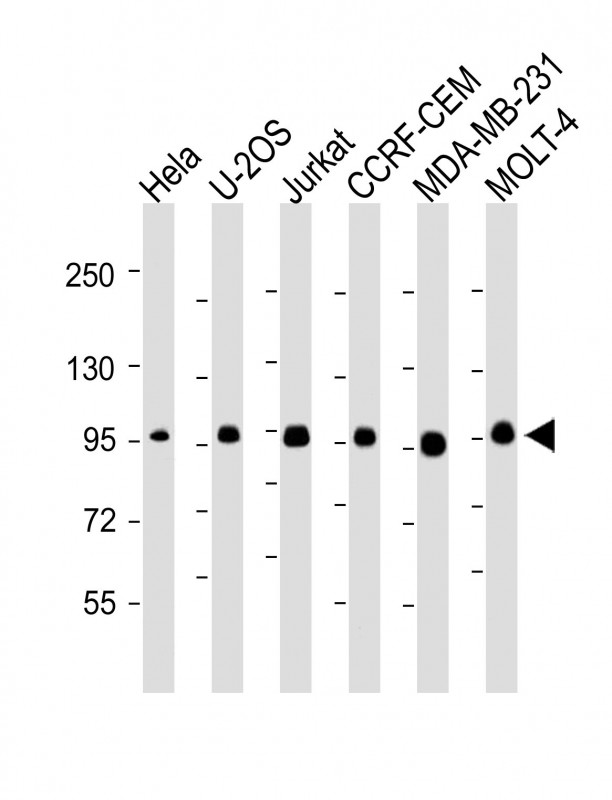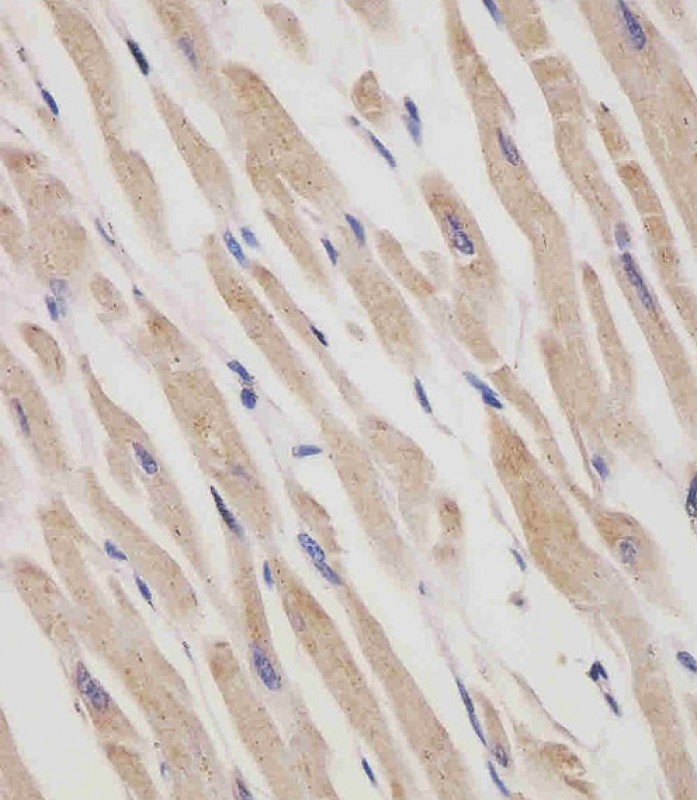
Mouse Anti-RANBP9 antibody
RANB9_HUMAN; Ran-binding protein 9; RanBP9; BPM-L; BPM90; Ran-binding protein M; RanBPM; RanBP7.
View History [Clear]
Details
Product Name RANBP9 Chinese Name 核蛋白9 / RanBinding proteinM单克隆抗体 Alias RANB9_HUMAN; Ran-binding protein 9; RanBP9; BPM-L; BPM90; Ran-binding protein M; RanBPM; RanBP7. Research Area Cell biology Cyclin Cell differentiation Epigenetics Immunogen Species Mouse Clonality Monoclonal Clone NO. B5F6 React Species Human, Applications WB=1:500-4000 IHC-P=1:25 IHC-F=1:25 (Paraffin sections need antigen repair)
not yet tested in other applications.
optimal dilutions/concentrations should be determined by the end user.Theoretical molecular weight 78kDa Cellular localization The nucleus cytoplasmic The cell membrane Form Liquid Concentration 1mg/ml immunogen Recombinant human RANBP9 between 1-388 amino acids. Lsotype IgG1,k Purification affinity purified by Protein G Buffer Solution 0.01M TBS(pH7.4) with 1% BSA, 0.03% Proclin300 and 50% Glycerol. Storage Shipped at 4℃. Store at -20 °C for one year. Avoid repeated freeze/thaw cycles. Attention This product as supplied is intended for research use only, not for use in human, therapeutic or diagnostic applications. PubMed PubMed Product Detail May act as an adapter protein to couple membrane receptors to intracellular signaling pathways. May be involved in signaling of ITGB2/LFA-1 and other integrins. Enhances HGF-MET signaling by recruiting Sos and activating the Ras pathway. Involved in activation of androgen and glucocorticoid receptor in the presence of their cognate hormones. Stabilizes TP73 isoform Alpha, probably by inhibiting its ubiquitination, and increases its proapoptotic activity. Inhibits the kinase activity of DYRK1A and DYRK1B. Inhibits FMR1 binding to RNA.
Tissue specificity: Ubiquitously expressed, with highest levels in testes, placenta, heart, and muscle, and lowest levels in lung. Within the brain, expressed predominantly by neurons in the gray matter of cortex, the granular layer of cerebellum and the Purkinje cells.
Function:
May act as an adapter protein to couple membrane receptors to intracellular signaling pathways. May be involved in signaling of ITGB2/LFA-1 and other integrins. Enhances HGF-MET signaling by recruiting Sos and activating the Ras pathway. Enhances dihydrotestosterone-induced transactivation activity of AR, as well as dexamethasone-induced transactivation activity of NR3C1, but not affect estrogen-induced transactivation. Stabilizes TP73 isoform Alpha, probably by inhibiting its ubiquitination, and increases its proapoptotic activity. Inhibits the kinase activity of DYRK1A and DYRK1B. Inhibits FMR1 binding to RNA.
Subunit:
Interacts with NGFR and DDX4 (By similarity). Interacts with GTP-bound Ran, AR, CDC2L1/p110C, CALB1, S100A7, USP11, MKLN1, SOS1 or SOS2, GID8, and FMR1. Interacts with the Dyrk kinases HIPK2, DYRK1A, and DYRK1B. Interacts with TP73 isoform Alpha but not with TP53. Interacts with the HGF receptor MET and the integrins ITGB1 and ITGB2, but not with ITGAL. Part of a complex consisting of RANBP9, MKLN1 and GID8. Part of a complex consisting of RANBP9, RAN, DYRK1B and COPS5. Directly interacts with RANBP10.
Subcellular Location:
Cytoplasm, cytosol. Nucleus. Note==Predominantly cytoplasmic. A phosphorylated form is associated with the plasma membrane.
Tissue Specificity:
Ubiquitously expressed, with highest levels in testes, placenta, heart, and muscle, and lowest levels in lung. Within the brain, expressed predominantly by neurons in the gray matter of cortex, the granular layer of cerebellum and the Purkinje cells.
Post-translational modifications:
Phosphorylated in response to stress. Can be phosphorylated by the cleaved p110 form of CDC2L1 (p110C). [PTM] Ubiquitinated. Polyubiquitination targets the protein for rapid degradation via the ubiquitin system. Can be deubiquitinated by USP11.
Similarity:
Belongs to the RANBP9/10 family.
Contains 1 B30.2/SPRY domain.
Contains 1 CTLH domain.
Contains 1 LisH domain.
SWISS:
Q96S59
Gene ID:
10048
Database links:Entrez Gene: 10048 Human
SwissProt: Q96S59 Human
Product Picture
Lane 1: Hela cell lysates
Lane 2: U-2OS cell lysates
Lane 3: Jurkat cell lysates
Lane 4: CCRF-CEM cell lysates
Lane 5: MDA-MB-231 cell lysates
Lane 6: MOLT-4 cell lysates
Primary: Anti-RANBP9 (SLM-51664M) at 1/2000~4000 dilution
Secondary: IRDye800CW Goat Anti-Mouse IgG at 1/20000 dilution
Predicted band size: 78 kD
Observed band size: 96 kD
Paraformaldehyde-fixed, paraffin embedded (human heart tissue sections); Antigen retrieval by boiling in sodium citrate buffer (pH6.0) for 15min; Block endogenous peroxidase by 3% hydrogen peroxide for 20 minutes; Blocking buffer (normal goat serum) at 37°C for 30min; Antibody incubation with (RANBP9) Monoclonal Antibody, Unconjugated (SLM-51664M) at 1:200 overnight at 4°C, followed by operating according to SP Kit(Mouse)(sp-0024) instructionsand DAB staining.
Bought notes(bought amounts latest0)
No one bought this product
User Comment(Total0User Comment Num)
- No comment




 +86 571 56623320
+86 571 56623320




